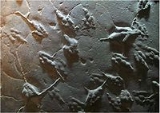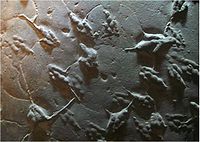
Connecticut River Valley trackways
Encyclopedia
The Connecticut River Valley trackways are the fossilised footprints of a number of Early Jurassic
dinosaur
s or other archosauromorphs from the sandstone
beds of South Hadley
, Massachusetts
. The finding has the distinction of being the first known discovery of dinosaur remains in North America.
A farm boy, Plinius Moody, came across the trackway
s in 1802. They were popularly regarded as bird footprints and they were so identified by the clergyman and president of Amherst College
E. B. Hitchcock
in his work Ichnology
of New England (1858). They were of significance to the naturalist and supporter of Darwin
, Thomas Huxley
. Huxley believed that birds evolved from an ancestral ratite
, and the large Massachusetts tracks seemed to support this. However, when Archaeopteryx
was discovered in 1861 it became apparent that the Connecticut River remains could not be those of birds and have since been reidentified as dinosaurs.
Hitchcock had the trackways removed and taken to the Amherst College Museum of Natural History, where they are displayed.

Early Jurassic
The Early Jurassic epoch is the earliest of three epochs of the Jurassic period...
dinosaur
Dinosaur
Dinosaurs are a diverse group of animals of the clade and superorder Dinosauria. They were the dominant terrestrial vertebrates for over 160 million years, from the late Triassic period until the end of the Cretaceous , when the Cretaceous–Paleogene extinction event led to the extinction of...
s or other archosauromorphs from the sandstone
Sandstone
Sandstone is a sedimentary rock composed mainly of sand-sized minerals or rock grains.Most sandstone is composed of quartz and/or feldspar because these are the most common minerals in the Earth's crust. Like sand, sandstone may be any colour, but the most common colours are tan, brown, yellow,...
beds of South Hadley
South Hadley, Massachusetts
South Hadley is a town in Hampshire County, Massachusetts, United States. The population was 17,514 at the 2010 census. It is part of the Springfield, Massachusetts Metropolitan Statistical Area....
, Massachusetts
Massachusetts
The Commonwealth of Massachusetts is a state in the New England region of the northeastern United States of America. It is bordered by Rhode Island and Connecticut to the south, New York to the west, and Vermont and New Hampshire to the north; at its east lies the Atlantic Ocean. As of the 2010...
. The finding has the distinction of being the first known discovery of dinosaur remains in North America.
A farm boy, Plinius Moody, came across the trackway
Fossil trackway
A fossil trackway is a type of trace fossil, a trackway made by an organism. Many fossil trackways were made by dinosaurs, early tetrapods, and other quadrupeds and bipeds on land...
s in 1802. They were popularly regarded as bird footprints and they were so identified by the clergyman and president of Amherst College
Amherst College
Amherst College is a private liberal arts college located in Amherst, Massachusetts, United States. Amherst is an exclusively undergraduate four-year institution and enrolled 1,744 students in the fall of 2009...
E. B. Hitchcock
Edward Hitchcock
Edward Hitchcock was a noted American geologist and the third President of Amherst College .-Life:...
in his work Ichnology
Ichnology
Ichnology is the branch of geology that deals with traces of organismal behavior, such as burrows and footprints. It is generally considered as a branch of paleontology; however, only one division of ichnology, paleoichnology, deals with trace fossils, while neoichnology is the study of modern traces...
of New England (1858). They were of significance to the naturalist and supporter of Darwin
Charles Darwin
Charles Robert Darwin FRS was an English naturalist. He established that all species of life have descended over time from common ancestry, and proposed the scientific theory that this branching pattern of evolution resulted from a process that he called natural selection.He published his theory...
, Thomas Huxley
Thomas Huxley
Thomas Henry Huxley PC FRS was an English biologist, known as "Darwin's Bulldog" for his advocacy of Charles Darwin's theory of evolution....
. Huxley believed that birds evolved from an ancestral ratite
Ratite
A ratite is any of a diverse group of large, flightless birds of Gondwanan origin, most of them now extinct. Unlike other flightless birds, the ratites have no keel on their sternum—hence the name from the Latin ratis...
, and the large Massachusetts tracks seemed to support this. However, when Archaeopteryx
Archaeopteryx
Archaeopteryx , sometimes referred to by its German name Urvogel , is a genus of theropod dinosaur that is closely related to birds. The name derives from the Ancient Greek meaning "ancient", and , meaning "feather" or "wing"...
was discovered in 1861 it became apparent that the Connecticut River remains could not be those of birds and have since been reidentified as dinosaurs.
Hitchcock had the trackways removed and taken to the Amherst College Museum of Natural History, where they are displayed.
List of identified footprints

- GrallatorGrallatorGrallator is an ichnogenus which covers a common type of small, three-toed print made by a variety of bipedal theropod dinosaurs. Grallator-type footprints have been found in formations dating from the late Triassic through to the early Cretaceous periods...
(small theropod) - EubrontesEubrontesEubrontes is the name of fossilised dinosaur footprints dating from the Late Triassic and Early Jurassic. They have been identified from France, Poland, Slovakia, Italy, Spain, Australia and the USA...
(larger theropod) - Anchisauripus (medium-sized theropod)
- OtozoumOtozoumOtozoum tracks are Jurassic age, fossilized footprints and other markings in sandstones. They were made by heavy, bipedal animals with a short stride that walked on four toes directed forward....
(large prosauropod) - AnomoepusAnomoepusAnomoepus gracillimus is the name assigned to fossil footprints first reported from Early Jurassic beds of the Connecticut River Valley, Massachusetts, USA in 1802....
(probably an ornithopodOrnithopodOrnithopods or members of the clade Ornithopoda are a group of ornithischian dinosaurs that started out as small, bipedal running grazers, and grew in size and numbers until they became one of the most successful groups of herbivores in the Cretaceous world, and dominated the North American...
)

